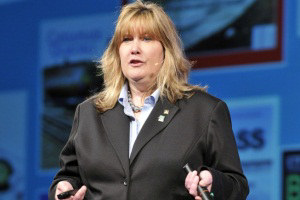Symposium challenges Agribusiness to make an impact

As the Alltech 29th Annual International Symposium came to a close, a closing session challenged delegates to take a glimpse into the future, search out opportunities to make an impact in the agribusiness industry and give the farmer of tomorrow a competitive advantage in the marketplace.
Speaking to more than 2,300 delegates from 72 countries, Rebecca Timmons¸ global director of applications research and quality for Alltech, kicked off the closing session highlighting the latest applications for algae in livestock and human nutrition.
While most of the attention on algae has focused primarily on it being a source for biofuel, microalgae contain large quantities of high quality eicosapentaenoic acid (EPA) and docosahexaenoic acid (DHA) that can bring additional nutritional improvements to feeds and food.
At Alltech’s Algae production facility in Winchester, Ky., Alltech SP-1 was recently developed to provide a consistent source of algae with a wide range of benefits for a variety of species as well as improvements for both ends of the value chain. Besides seeing an increase in immunity, a decrease in mortality and increased litter size in their herds, producers who utilise feeds with this type of algae will also be able to further brand their products as value-added DHA Omega-3 enriched for consumers.
“It’s going to be two-fold; you’re going to have those benefits to the animals as well as through the enriched product to consumers. This means you will be improving your return while creating a healthier population of both humans and animals all at the same time,” Timmons said. “We can really change the way we feed the world, so we are not just looking at feeding the world but feeding them in a better way.”
Dr. Mark Lyons, vice president of corporate affairs at Alltech also stressed the importance of food safety as he shared the company’s vision for helping expand agricultural production in China. According to Lyons, food security is seen as “the potential Achilles’ heel of China” and is too big of an issue to ignore publicly.
China’s five-year plan focuses on making farms larger, more efficient and more traceable. For example, half of the world’s pigs live in China and from those 50 million sows, 20 pigs per sow are born alive per year. This equals an annual production of one billion pigs per year. However, due to preweaning mortality, only 600 million actually go to market. The 400 million lost is three times the size of US pig production. In China, one more pig per sow per year would mean one million tons of feed saved.
“What is Alltech’s five-year plan? We want to be a foreign brand with a Chinese heart,” Lyons said. “We want to firmly establish market leadership, partner with the government and leading feed, production and food companies, and give our customers a competitive advantage.”
Founder and president of Alltech, Dr. Pearse Lyons wrapped up Symposium, challenging the delegates to help the farmer of tomorrow and to use the resources provided to them at this year’s event. “Are you going to fly or are you going to soar? Will you flourish?” Dr. Lyons asked. “You need to leave here today and say, ‘I may not rule the world, but I can have an impact on feeding the world’s growing population.’”








